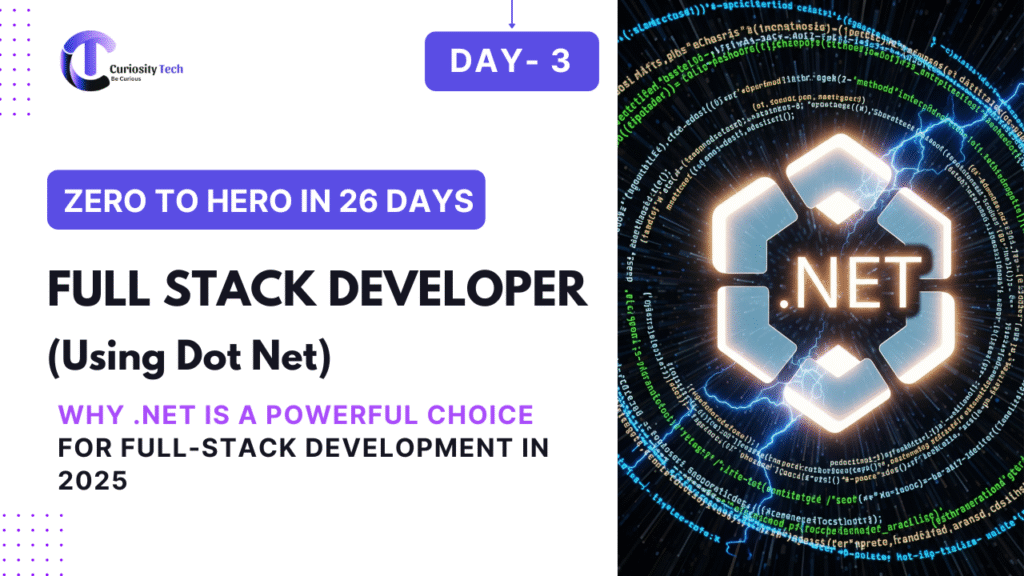In the fast-changing world of software engineering, choosing the right stack can define how successful a project becomes. Among the countless frameworks and technologies available, .NET has continued to evolve into one of the most powerful ecosystems for Full Stack Development in 2025.
From robust backend APIs to interactive frontends, .NET provides an end-to-end solution for developers and businesses alike. But why does it stand out in 2025 when alternatives like JavaScript frameworks, Python stacks, and PHP solutions are also widely used? Let’s dive deeper.
1. Unified Full Stack Ecosystem
Unlike other stacks where you often need different languages for frontend and backend, .NET offers a cohesive ecosystem with C#, ASP.NET Core, Blazor, and Entity Framework Core.
| Layer | .NET Technology | Key Advantage |
| Frontend (UI) | Blazor / Razor Pages | Write C# instead of JavaScript, seamless UI |
| Backend (Logic) | ASP.NET Core | High performance, scalable APIs |
| Database (Data) | EF Core / LINQ | Easy ORM, faster database operations |
| DevOps & Hosting | Azure Integration | Cloud-ready deployments with CI/CD |
This hierarchical approach helps both beginners and enterprises maintain consistency and productivity across the full stack.

2. Future-Ready with Cloud & AI Integration
In 2025, software isn’t just about building websites—it’s about creating cloud-ready, AI-driven, and scalable digital experiences. .NET integrates tightly with Azure, making cloud deployment straightforward.
Additionally, with ML.NET and integrations for AI APIs, developers can now infuse applications with machine learning models, natural language processing, and predictive analytics—without leaving the .NET ecosystem.

3. Performance & Scalability
One of the reasons companies continue to choose .NET is its unmatched performance. ASP.NET Core regularly tops benchmarks for web server speed and stability. This makes it ideal for enterprise-scale applications, fintech, e-commerce, and real-time platforms.
With asynchronous programming, SignalR for live data, and caching mechanisms, .NET apps scale effortlessly to support thousands (or millions) of users.
4. Cross-Platform Flexibility
Gone are the days when .NET was limited to Windows. Today, with .NET 8 and beyond, developers can build apps for Windows, Linux, macOS, iOS, and Android from the same codebase.
This cross-platform capability makes it a future-proof investment for organizations and an attractive skill set for developers who want global opportunities.
5. Industry Trust & Career Opportunities
Top enterprises like Microsoft, Stack Overflow, Accenture, and HSBC rely on .NET. That trust in the ecosystem ensures long-term demand for skilled Full Stack .NET developers.
For students and working professionals, learning .NET in 2025 isn’t just about coding—it’s about building a career that blends stability, innovation, and global demand.
And that’s where platforms like CuriosityTech.in play a key role. By focusing on hands-on training, real-world projects, and mentorship from experienced professionals, Curiosity Tech ensures learners not only understand .NET but can also deploy full-fledged applications on the cloud. Their active presence on platforms like Instagram (@curiositytechpark), LinkedIn (Curiosity Tech), and Facebook keeps learners connected with industry updates and opportunities.
Conclusion
In 2025, .NET is more than just a framework—it’s an entire ecosystem built for the future. Whether you’re a student starting your coding journey or a professional aiming for career growth, mastering .NET gives you a competitive edge in today’s digital-first economy.
By combining backend strength, frontend flexibility, cross-platform development, and cloud readiness, .NET positions itself as the go-to stack for building scalable, secure, and innovative applications.
So, if you’re looking to step into Full Stack development, choosing .NET today means you’re choosing a future-ready career path.



